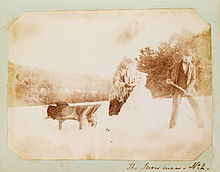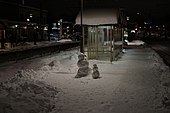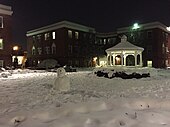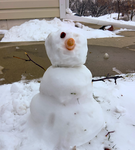Snowman

A snowman is an anthropomorphic snow sculpture of a man often built in regions with sufficient snowfall and is a common winter tradition. In many places, typical snowmen consist of three large snowballs of different sizes with some additional accoutrements for facial and other features. Due to the sculptability of snow, there is also a wide variety of other styles. Common accessories include branches for arms and a smiley face made of stones, with a carrot used for a nose. Clothing, such as a hat or scarf, may be included.
Construction
[edit]Snow becomes most suitable for packing when it approaches its melting point and becomes moist and compact. Making a snowman of powdered snow is difficult since it will not stick to itself, and if the temperature of packing snow drops, it will form an unusable denser form of powdered snow called the crust. Thus, a good time to build a snowman may be the next warm afternoon directly following a snowfall with a sufficient amount of snow. Using more compact snow allows for the construction of a large snowball by simply rolling it until it grows to the desired size. If the snowball reaches the bottom of the grass it may pick up traces of grass, gravel, or dirt.
In North America, snowmen are generally built with three spheres representing the head, torso, and lower body.[1] In the United Kingdom, two spheres are used, one sphere representing the body and one representing the head. The usual practice is to then decorate and optionally dress the snowman. Sticks can be used for arms, and a face is traditionally made with stones or coal for eyes and a carrot for a nose. Some like to dress their snowmen in clothing such as a scarf or hat, while others prefer not to risk leaving supplies outdoors where they could easily be stolen or become stuck under melting ice.
There are variations to these standard forms; for instance, the popular song "Frosty the Snowman" describes a snowman being decorated with a corncob pipe, button nose, coal eyes and an old silk hat (usually depicted as a top hat). These other types range from snow columns to elaborate snow sculptures similar to ice sculptures.
-
A "snow family" in Boise, Idaho,with various accessories
-
Snowman in Frankfurt, Germany
-
A snowman in Allendale, Northumberland, United Kingdom
-
Two small snowmen on a train station in Täby, Sweden
-
Snowman with hat, scarf, and winter gloves in Germany
-
Snowman in an apartment courtyard at night in Virginia, United States
One book describes classic snowman attachments as a black felt top hat, red scarf, coal eye pieces, carrot nose, and corn cob pipe.[2]
History
[edit]
Documentation of the first snowman is unclear. However, Bob Eckstein, author of The History of the Snowman, documented snowmen from the Middle Ages by researching artistic depictions in European museums, art galleries, and libraries. The earliest documentation he found was an antisemitic marginal illustration from a 1380 book of hours, found in the Koninklijke Bibliotheek in The Hague.[3][4] Michelangelo was commissioned by Piero de' Medici to make a snowman in 1494.[5] The earliest known photograph of a snowman was taken circa 1853 by Welsh photographer Mary Dillwyn, the original of which is in the collections of the National Library of Wales.
While the origin of snowmen remains unclear, they have been used throughout history to make statements. In 1511, the city of Brussels held a snowman festival in hopes of appeasing its hungry and poor citizens. However, instead of building snowmen, the people built pornographic sculptures throughout the city.[6]
The concept of snowmen had made its way to North America by the Schenectady Massacre of 1690. It is said that on the night of the massacre, two guards who were in charge of guarding the north gate of the settlement of Schenectady built two snowmen to guard the gates while they went to the pub.[7]
Snowmen became more popular when the character “Frosty the Snowman” came out, which originated from a song of the same name in 1950.[8][9]
In popular culture
[edit]In media
[edit]
Snowmen are a popular theme for Christmas and winter decorations and also in children's media. A famous snowman character is Frosty, the titular snowman in the popular holiday song "Frosty the Snowman" (later adapted into film and television specials), who was magically brought to life by the old silk hat used on his head. In addition to numerous related music and other media for Frosty, snow-men also feature as:
- Bouli, a French animated series about a snowman's adventures in a magical place.
- Der Schneemann, a 1943 animated short film created in Germany.
- Doc McStuffins features a plush snowman named Chilly.
- The Peanuts comic strip has a number of strips where the characters build snowmen in the winter months. One memorable serial has the gang forbidden to build snowmen because they lack the necessary government permits. Defiantly, Charlie Brown builds an unauthorized snowman in the middle of the night to serve as a test case.
- Jack Frost, a 1997 horror film in which a serial killer is transformed into a snowman.
- Jack Frost, a 1998 movie with Michael Keaton in which he wakes up as a snowman after a car accident.
- Oswald features a snowman named Johnny who runs an ice cream shop.
- The Snowman, British picture book (1978) by Raymond Briggs and animation (1982) directed by Dianne Jackson about a boy who builds a snowman that comes alive and takes him to the North Pole.
- Tabaluga's main antagonist in his series is an evil snowman called Arktos.
- In Pokémon the Ice Type Galarian Forms of Darumaka and Darmanitan are based on the Yeti, whereas Darmanitan's Zen Mode which is Ice/Fire is based on the Snowman.
- Calvin and Hobbes, an American cartoon by Bill Watterson, contains many instances of Calvin building snowmen, many of which are deformed or otherwise abnormal, often used to poke fun at the art world.
- Hans Christian Andersen wrote a winter fairy story, The Snowman.
- Dennis Jürgensen's horror story "The Snowman", is about a boy traumatized by being locked in a meat freezer.
- R. L. Stine's Goosebumps story titled "Beware, the Snowman" featured a monstrous snowman.
- The 2013 film Frozen features a living snowman named Olaf who longs to see summer. The film score includes a song about building a snowman.[10]
Snowman-themed items
[edit]Snowmen can also be a theme for toys, costumes, and decorations. They have been featured on New Year stamps, for example, in Russia and other post-Soviet states.
One common time for snowman-themed decorations is during the winter holiday and Christmas season, where it is celebrated.[11] One craft book suggested a plan making a small snowman doll out of white glove, ribbon, and other craft supplies.[11]
One book on snowmen, which included instructions on working with real snow, also mentions snowman-themed sweets and confections.[12] Some options for snowman-themed dessert items include ice cream, marshmallows, and macaroons.[12]
-
Snowman-themed cookies
-
Snowman-inspired bronze sculpture
-
Person in snowman costume
-
Snowman display statue
Giant snowmen and records
[edit]
In 2015, a man from the U.S. state of Wisconsin was noted for making a large snowman 22 feet tall and with a base 12 feet wide.[13]
The record for the world's largest snowman or snowwoman was set in 2008 in Bethel, Maine. The snowwoman stood 122 feet 1 inch (37.21 m) in height, and was named Olympia in honor of Olympia Snowe, a U.S. Senator representing the state of Maine.[14][15]
The previous record was a snowman built in Bethel, Maine, in February 1999. The snowman was named "Angus, King of the Mountain" in honor of the then-current governor of Maine, Angus King. It was 113 feet 7 inches (34.62 m) tall and weighed over 9,000,000 pounds (4,080,000 kg).[16]
A large snowman known as "Snowzilla" has been built each winter in Anchorage, Alaska.
In December 2016 the smallest snowman of sorts was created in a nano-fabrication facility at University of Western Ontario.[17] It consisted of three roughly 0.9 micron spheres of silica, platinum arms and nose, and a face made by an ion beam.[17]
Variations
[edit]In addition to snowmen, other things can be made from snow. Typical variations on the snowman concept involve producing other snow creatures or snow decorations.
A snow sculpture of a woman is called a snowwoman. In some Slavic countries, a variation of the snowman is often constructed called a snow grandma. this only uses two snowballs.
-
The world's largest snowwoman or snowman, a 122 feet 1 inch (37.21 m) tall snowwoman from 2008, named Olympia in honor of Olympia Snowe
-
Snowwomen can be as hard to photograph as snowmen. Here two assistants hold up a blanket behind the sculpture to increase the contrast. Photograph circa 1910
Yuki Cone
[edit]The Yuki Cone, named after the Japanese word for snow, involves building a small cone-shaped structure from snowballs, illuminated from the inside with a tea-light.

Other variants
[edit]Sometimes other raw material might be used to create objects that mimic the snowman concept.
-
Snowrabbit
-
Desert "snowmen" in Tohono Chul Park, Tucson, Arizona, made out of tumbleweeds
-
Timelapse video of making of a "snowman" from logs
-
A "sandman" constructed from wet sand on Indian Rocks Beach, Florida.
Japan
[edit]In Japanese, snowmen are called "Yukidaruma" (Japanese: 雪だるま). Possibly because the shape is related to a Daruma doll, they usually only have two sections instead of three.[18] There is also a longstanding tradition in Japan of creating snow rabbits, or "Yukiusagi" (Japanese: 雪うさぎ).[19]
-
Japanese snowman ("Yukidaruma") with 2 parts and a bucket hat.
-
Painting the Eyes on a Snow Rabbit by Isoda Koryūsai (circa 1780, Japan) depicts a rabbit snow sculpture.
-
A Mickey Mouse-inspired snowman in Sapporo, Japan
Unicode
[edit]| Sample | Unicode | HTML | Description |
|---|---|---|---|
| ☃ | U+2603 | ☃ | Snowman |
| ⛄ | U+26C4 | ⛄ | Snowman without snow |
| ⛇ | U+26C7 | ⛇ | Black snowman |
See also
[edit]References
[edit]- ^ "Snowmen: Slowly Melting Away Forever?". News Shopper. 21 February 2012. Retrieved 20 December 2017.
- ^ Armstrong, Nancy; McCauley, Adam (1 January 2002). Snowman in a Box: Everything You Need to Build Classic and Cool Snow Creations Just Add Snow Even Works in Sand!. Running Press Book Publishers. ISBN 9780762413522.
- ^ Eckstein, Bob (2007). The history of the snowman: from the Ice Age to the Flea Market. Internet Archive. New York: Simon Spotlight Entertainment. pp. 141–3. ISBN 978-1-4169-4066-1.
- ^ Eckstein, Bob (2 December 2008). "My Search for The First Snowman". The History of the Snowman. Open Salon. Archived from the original on 4 March 2010. Retrieved 11 January 2010.
- ^ Andres, G.M., Hunisak, J.M., Turner, A.R., "The Art of Florence", Artabras, New York, 1994, p. 960
- ^ Garau, Annie (5 January 2017). "The Snowman's Oddly Political History". All That's Interesting. John Kuroski. Retrieved 17 March 2022.
- ^ "The Fun and Frosty History of Snowmen". Farmers' Almanac. Almanac Publishing. 8 December 2017. Retrieved 17 March 2022.
- ^ Sauer, Patrick (5 December 2016). "The Evolution Of The Snowman: From The Magical Frosty To The Exploding Böögg". Fatherly. Retrieved 17 March 2022.
- ^ "Frosty the Snowman | Encyclopedia.com". 7 April 2022. Archived from the original on 7 April 2022.
- ^ "Review: Do you want to build a snowman?". 13 February 2014.
- ^ a b Ross, Kathy (1 January 2002). The Best Christmas Crafts Ever!. Millbrook Press. ISBN 9780761316886.
- ^ a b Cole, Peter; Frankeny, Frankie; Jonath, Leslie (1 September 1999). Snowmen: Creatures, Crafts, and Other Winter Projects. Chronicle Books. ISBN 9780811825542.
- ^ "Wisconsin man builds giant Olaf snowman". 21 February 2015.
- ^ "Topping 122 Feet, Snowman in Maine Vies for World Record". Fox News (Associated Press). 1 March 2008. Retrieved 8 January 2016.
- ^ "Tallest snowman". Guinness World Records. 26 February 2008. Retrieved 8 January 2016.
- ^ "Angus, King of the Mountain — World's Largest Snowman". Sunday River On-Line. 19 February 1999. Archived from the original on 12 October 2007.
- ^ a b "Researcher created the world's smallest snowman". 23 December 2016.
- ^ "Netsuke in the form of a boy rolling a yuki daruma, or snowman". collections.ashmolean.org. Retrieved 15 February 2021.
- ^ Hall, Stephanie (14 January 2018). "Yuki Usagi: The Japanese Snow Hare | Folklife Today". blogs.loc.gov. Retrieved 28 January 2019.
Further reading
[edit]- Eckstein, Bob The History of the Snowman: From the Ice Age to the Flea Market at Internet Archive. New York, Simon Spotlight Entertainment, 2007
- Davis, Scottie Snow Day, A Photographic Journal of the Best Snowmen (2004).




















